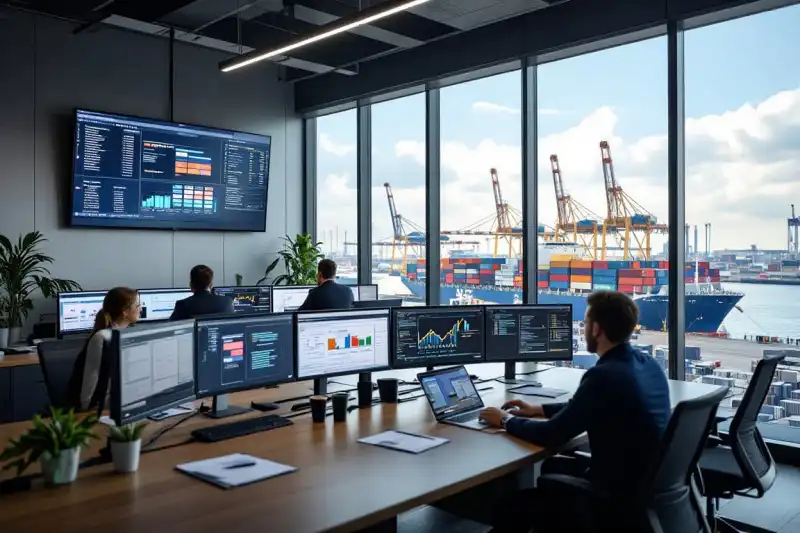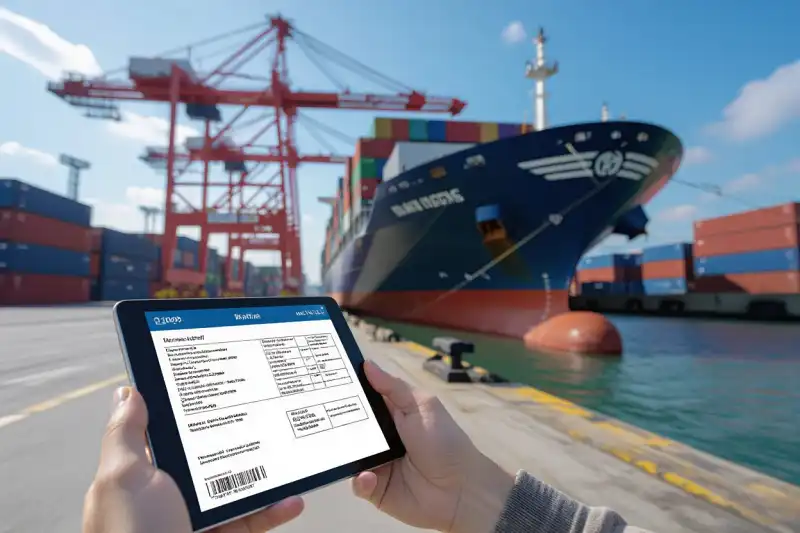With the shipping industry evolving rapidly, you can no longer rely on outdated paper bills of lading. Electronic Bills of Lading (eBLs) offer your business a secure, faster, and more transparent way to manage shipping documents, reducing risks like fraud and delays. As a professional in international trade, embracing eBLs means you enhance compliance and efficiency—transforming your supply chain operations. Platforms like Chaindox leverage blockchain technology to ensure your digital trade documents are verifiable and legally compliant, giving you peace of mind while streamlining workflows.
Chaindox, a digital trade documentation platform, enables you to seamlessly transition from paper to secure, verifiable Electronic Bills of Lading (eBLs) using blockchain infrastructure. With legal alignment to UNCITRAL MLETR and built-in smart compliance checks, Chaindox helps modernize your supply chain with confidence.
The Digital Transformation of Shipping
Shipping’s evolution from paper-laden processes to digital platforms has accelerated your ability to manage complex global logistics. By integrating electronic documentation, the industry reduces delays attributed to lost or forged papers, cutting transaction times from days to mere hours. This shift enhances visibility across every touchpoint—empowering you to monitor shipments in real time and ensuring compliance with international regulations without cumbersome manual checks.
The Role of Technology in Logistics
Your logistics operations increasingly rely on technologies like blockchain, IoT sensors, and cloud computing to automate and secure data exchange. Blockchain ensures immutable records, while IoT devices provide live updates about a consignment’s location and condition. Cloud platforms centralize this information, allowing stakeholders—carriers, customs officials, and you—to collaborate seamlessly, driving smarter decision-making and reducing operational costs.
E-Bills of Lading: The Game Changer
E-bills of lading (eBLs) replace traditional paper documents with legally recognized digital versions, eliminating manual handling errors and accelerating cargo release. Over 90% of global container shipping companies have begun adopting eBLs, finding they reduce fraud risks while enhancing transaction transparency. As an innovation, eBLs offer you the agility to close deals faster, optimize cash flow, and strengthen trade security.
Delving deeper, eBLs leverage cryptographic technology to safeguard document authenticity and ownership transfer. Platforms like Chaindox use blockchain to create tamper-evident records accessible only to authorized parties, significantly reducing the risk of disputes.
For your company, this means smoother financing options, faster inland clearance, and improved trust among trading partners—advantages particularly impactful for MSMEs looking to level the playing field in global markets.
While many providers offer eBL technology, Chaindox stands out with an end-to-end digital documentation suite. Built on XDC Network, Chaindox offers:
- Tamper-evident blockchain-based documents
- Real-time sharing and access control
- Compliance with MLETR, ICC, and DCSA standards
- Custom workflows for MSMEs and enterprises
With Chaindox, businesses can implement eBLs confidently, backed by legal validity and technical resilience.
Environmental Impact: Reducing Paper Waste
Your shipping operations consistently consume vast quantities of paper documents, contributing to deforestation and landfill overflow. Transitioning to electronic Bills of Lading (eBLs) slashes paper usage dramatically, cutting the environmental toll associated with printing, storage, and disposal.
Each traditional Bill of Lading can comprise multiple pages; when multiplied across millions of shipments annually, the paper waste becomes staggering. By adopting eBLs, you not only streamline your processes but also play a significant role in reducing waste, conserving precious natural resources, and fostering a greener supply chain ecosystem.
The Carbon Footprint of Traditional Shipping
Conventional maritime documentation relies heavily on physical paperwork, resulting in a significant carbon footprint beyond just vessel emissions. The production, transportation, and storage of shipping documents consume energy and contribute an estimated millions of tons of CO2 annually.
Additionally, transport delays often cause shipments to remain idle longer, further increasing emissions and resource consumption. Your reliance on paper manifests hidden environmental costs—in energy used by print facilities and the endless supply chain for paper manufacturing—that ultimately inflate shipping’s overall carbon footprint.
Sustainability Benefits of E-BLs
Utilizing eBLs eliminates the dependence on paper documentation, substantially lowering resource consumption and emissions associated with traditional shipping paperwork. Digital platforms enable secure, instantaneous document exchange, reducing delays that exacerbate fuel consumption and emissions.
Reports indicate that transitioning to eBLs can cut carbon emissions per transaction by up to 90% compared to paper-based processes. This eco-friendly shift helps your company meet compliance with increasingly stringent environmental regulations while boosting operational efficiency and reducing costs.
Beyond cutting paper waste, eBLs also reduce energy consumption linked to document handling and logistics. By digitizingBill of Lading workflows, you minimize the need for physical storage and courier services, sharply decreasing associated greenhouse gas emissions.
Blockchain-enabled platforms like Chaindox ensure tamper-proof and accessible trade documents, drastically reducing duplicated shipments and lost paperwork that otherwise result in wasteful reshipments. Implementing eBLs supports your environmental, social, and governance (ESG) targets, positioning your business as a sustainable leader within global supply chains.

Elevating Security and Efficiency
Implementing eBLs dramatically enhances your shipping security by embedding data verification directly into the document’s digital fabric. This integration reduces administrative overhead while tightening control over cargo handling and ownership transfer. By digitizing bills of lading, you eliminate vulnerabilities inherent in paper systems, such as loss or counterfeit, safeguarding your shipments with robust blockchain validation.
The operational efficiency gained not only cuts down paperwork time but also accelerates the entire supply chain process, allowing you to respond faster to market demands with increased transparency.
Reducing Fraud and Enhancing Verification
eBLs utilize blockchain technology, which ensures every transaction is time-stamped and immutable, making it significantly harder for fraudulent documents to infiltrate your shipping process.
This layer of cryptographic security means you can verify the authenticity of a bill of lading instantly without relying on third-party intermediaries. In turn, you minimize risks associated with forged documents, preventing financial losses and legal disputes while supporting compliance protocols more effectively than traditional paper-based methods.
Streamlining Operations for Faster Delivery
With eBLs, the turnaround time from cargo dispatch to delivery is cut substantially as you can handle document transfer and ownership confirmation digitally in real-time. This eliminates bottlenecks caused by physical document delivery or postal delays, especially on international routes.
Companies like Maersk have reported up to a 40% reduction in processing time using blockchain-enabled eBL solutions, leading to expedited customs clearance and smoother coordination between stakeholders, ultimately resulting in faster delivery and reduced demurrage costs.
Further enhancing your operational workflow, eBLs automate data entry and synchronization across multiple parties, including carriers, freight forwarders, and customs authorities. This seamless data sharing minimizes manual errors, improves inventory tracking accuracy, and enables just-in-time decision-making.
By integrating eBLs into your SCM platforms, you benefit from end-to-end visibility and control, enabling proactive responses to exceptions and reducing the average shipping cycle from days to mere hours.

Legal Perspectives: The Shift Towards Acceptance
Legal systems worldwide have begun recognizing electronic bills of lading (eBLs) as valid and enforceable, reflecting a significant shift from traditional paper dominance. Jurisdictions like Singapore and the UK have enacted legislation explicitly endorsing eBLs, providing clear frameworks that reduce risks associated with digital documents.
By adapting laws to accommodate blockchain technology and digital signatures, you benefit from enhanced trust and smoother cross-border transactions. This move bridges the gap between technology and legal certainty, enabling you to confidently replace paper-based processes without sacrificing compliance or security.
Adapting Regulatory Frameworks
Regulators are modernizing maritime and trade laws to integrate eBLs seamlessly into international commerce. The Rotterdam Rules and UNCITRAL Model Law on Electronic Transferable Records offer guidelines that many countries incorporate, ensuring legal equivalence between electronic and paper instruments.
You’ll notice increased alignment across jurisdictions, minimizing conflicting rules that previously hindered digital adoption. Additionally, authorities are emphasizing standardized protocols for identity verification and data integrity, reinforcing eBL legitimacy. This regulatory evolution facilitates smoother adoption for your business by providing a stable legal environment that supports innovation without compromising regulatory oversight.
The Future of Electronic Documentation in Trade
The trajectory of electronic documentation signals a growing reliance on blockchain and distributed ledger technologies for trade documents beyond bills of lading. It’s predicted that over 70% of global shipping volumes will use eBLs or similar digital records by 2028, driven by efficiencies and cost reductions hard to ignore. Your digital ecosystem will integrate multiple documents—customs declarations, certificates of origin, invoices—streamlining workflows.
Expanding this ecosystem further, projects like the Digital Container Shipping Association (DCSA) are creating open standards that unify electronic documentation, enabling interoperability between different carriers, ports, and regulatory bodies.
These advancements mean your trading partners can collaborate in real time with secure, tamper-proof documents, accelerating clearance, reducing fraud, and improving auditability. Embracing this shift positions your operations at the forefront of a trade transformation, setting the stage for faster, smarter, and more compliant international logistics.
Bridging the Gap: Adoption Challenges and Solutions
Switching to eBLs can feel daunting due to entrenched habits and regulatory complexities. You might face pushback from stakeholders hesitant to abandon familiar paper processes, alongside inconsistencies in legal recognition across jurisdictions.
Overcoming these hurdles demands a strategic approach targeting education, technology integration, and advocacy for updated regulations. By addressing these points head-on, your company can not only streamline operations but also set a benchmark in digital shipping innovation.
Resistance from Traditionalists
Traditionalists often cling to paper bills because they trust the tangible control and are wary of digital security risks. Concerns about legal enforceability and system interoperability add to hesitation, especially in industries with tight compliance standards.
You’ll encounter skepticism about reliability and fears that digital processes might fail during disputes or audits. Understanding these fears can help you engage in more informed discussions and create tailored demonstrations that showcase the robustness and legality of eBL solutions.
Strategies for Successful Transition
Gradually integrating eBLs by running parallel systems initially allows you to build confidence among hesitant partners. Training sessions that highlight real-world successes, paired with clear legal endorsements, make the benefits more tangible.
Piloting eBLs in smaller, controlled shipments can reduce risk and reveal process improvements before full-scale adoption. Leveraging platforms like Chaindox ensures compliance and traceability, which you can highlight to ease concerns about security and authenticity.
Expanding on this strategy, engaging legal teams early helps tailor eBL contracts to comply with local laws, smoothing regulatory approval. Sharing data-driven case studies that illustrate cost reductions—some firms report up to 25% savings in document handling—strengthens your argument.
Collaboration platforms facilitate seamless communication across your supply chain, integrating stakeholders incrementally instead of all at once. Such phased approaches prevent disruptions and foster trust, enabling you to harness eBLs’ full potential without alienating traditional partners.
Final Words
With this in mind, you can see how eBLs revolutionize shipping by replacing cumbersome paper processes with secure, efficient digital solutions. Leveraging platforms like Chaindox not only streamlines your trade documentation but also enhances transparency and compliance across your supply chain. By adopting eBLs, you’re positioning your business to respond faster and more reliably in today’s dynamic international trade environment, ultimately reducing costs and minimizing risks associated with manual errors and fraud.
📢 Looking to implement secure, compliant eBLs?
Discover how Chaindox enables faster, fraud-resistant, and regulation-ready trade documentation.
👉 Visit Chaindox.com to get started or book a demo.
